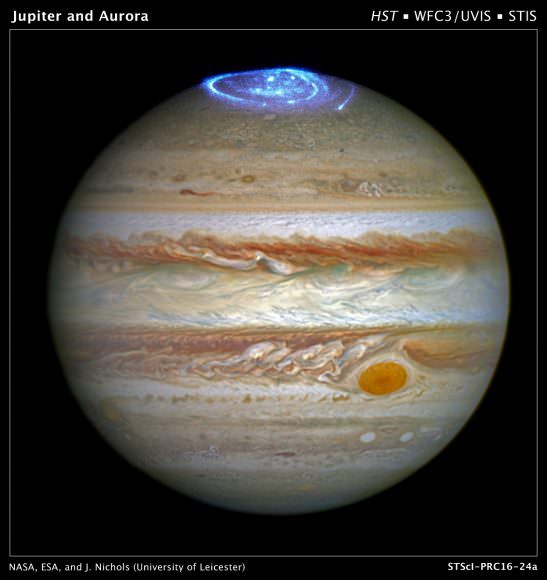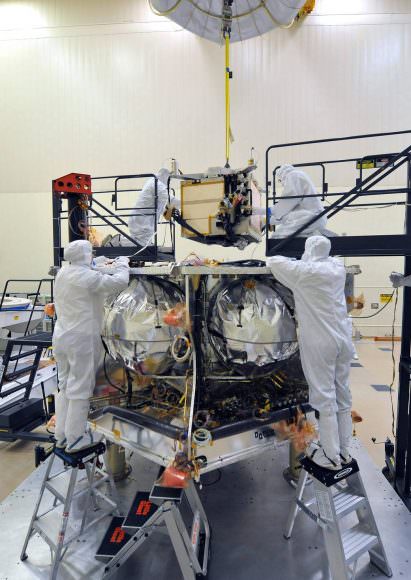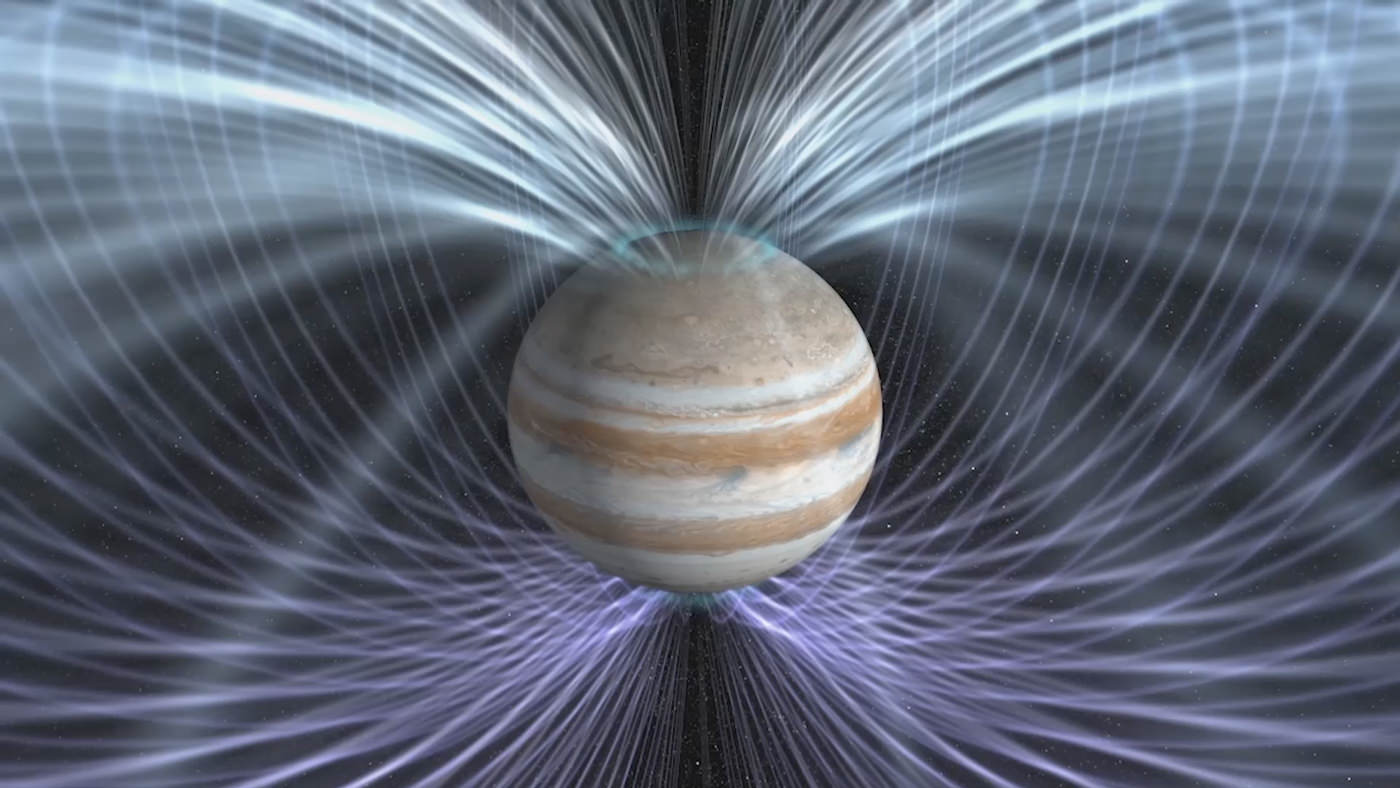Jupiter is a huge planet, but its magnetosphere is mind-blowingly massive. It extends out to nearly 5 million kilometers (3 million miles) wide on average, 150 times wider than Jupiter itself and almost 15 times wider than the Sun, making it one of the largest structures in the Solar System.
“If you were to look up into the night sky and if we could see the outline of Jupiter’s magnetosphere, it would be about the size of the Moon in our sky,” said Jack Connerney, deputy principal investigator and head of the Juno mission magnetometer team. “It’s a very large feature in our Solar System, and it’s a pity we can’t see it.”
But the Juno spacecraft is about to change our understanding of Jupiter’s magnetosphere and allow scientists to “see” for the first time Jupiter’s magnetic field.
And today, NASA announced that Juno has entered Jupiter’s magnetic field. Listen to the video below as the spacecraft gathered data as it crossed the bow shock:
A magnetosphere is the area of space around a planet that is controlled by the planet’s magnetic field. The stronger the magnetic field, the larger the magnetosphere. It is estimated that Jupiter’s magnetic field is about 20,000 times stronger than Earth’s.

Magnetic fields are produced by what are known as dynamos – an electric current created from the convection motion of a planet’s interior. Earth’s magnetic field is generated by its circulating core of molten iron and nickel. But what creates Jupiter’s dynamo? Is it like Earth’s or could it be very different? Jupiter consists predominantly of hydrogen and helium, and it is currently unknown if there is a rocky core at the center of the planet.
“With Jupiter, we don’t know what material is producing the planet’s magnetic field,” said Jared Espley, Juno program scientist for NASA Headquarters, “What material is present and how deep down it lies is one of the questions Juno is designed to answer.”
Juno has a pair of magnetometers to basically look inside the planet. The magnetometers will allow scientists to map Jupiter’s magnetic field with high accuracy and observe variations in the field over time. The instruments will be able to show how the magnetic field is generated by dynamo action deep in the planet’s interior, providing the first look at what the magnetic field looks like from the surface of the dynamo where it is generated.
“The best way to think of a magnetometer is like a compass,” said Connerney. “Compasses record the direction of a magnetic field. But magnetometers expand on that capability and record both the direction and magnitude of the magnetic field.”
But Jupiter presents a lot of problems as far as being nice to instruments. Trapped within the magnetosphere are charged particles from the Sun that form intense radiation belts around the planet. These belts are similar to the Earth’s Van Allen belts, but are many millions of times stronger.
To help protect the spacecraft and instrument electronics, Juno has a radiation vault about the size of a car trunk made of titanium that limits the radiation exposure to Juno’s command and data handling box (the spacecraft’s brain), power and data distribution unit (its heart) and about 20 other electronic assemblies. But the instruments themselves need to be outside of the vault in order to make their observations.

The magnetometer sensors are on a boom attached to one of the solar arrays, placing them about 40 feet (12 meters) from the body of the spacecraft. This helps ensure that the rest of the spacecraft does not interfere with the magnetometer.
But there are other ways to help limit the amount of radiation exposure, at least in the first part of the mission.
Scientists designed a path that takes Juno around Jupiter’s poles so that the spacecraft spends the least amount of time possible in those blistering radiation belts around Jupiter’s equator. Engineers also used designs for electronics already approved for the Martian radiation environment, which is harsher than Earth’s, though not as harsh as Jupiter’s.
That elliptical orbit — between radiation belt and the planet — also puts the spacecraft very close to Jupiter, about 5,000 km above the cloud tops, enabling a close-up look at this amazing planet.
“This is our first opportunity to do very precise, high-accuracy mapping of the magnetic field of another planet,” Connerney said. “We are going to be able to explore the entire three-dimensional space around Jupiter, wrapping Jupiter in a dense net of magnetic field observations completely covering the sphere.”
By studying Jupiter’s magnetosphere, scientists will gain a better understanding about how Jupiter’s magnetic field is generated. They also hope to measure how fast Jupiter is spinning, determine whether the planet has a solid core, and learn more about Jupiter’s formation.
“It’s always incredible to be the first person in the world to see anything,” Connerney said, “and we stand to be the first to look down upon the dynamo and see it clearly for the first time.”
Further reading: Juno mission page, NASA article on Juno’s magnetometer.


Strong magnetic fields can cause feelings of dread and hallucinations, whether Jupiter’s field is that strong remains to be seen.
For magnetic fields to affect the brain they have to be very strong, localized to one section of the brain, and oscillating.
Anybody who has had a MRI where the magnetic field covers the entire head, and has a strength of 1.5 or 3 Tesla (Very Very Strong), has noted that it does not affect thoughts during the process.
The only problems are claustrophobia and the loud noises of the machine.
soooo… was there any evidence that the magnetic field was stronger than expected and will, then, cause unpredicted damage to Juno? If not, what is the meaning of the title of this article?
Also, am I the only person that is in love with the ending of Goddard Space Flight Center videos on YouTube? Beep beep… Beep beep…